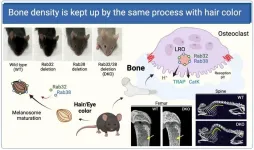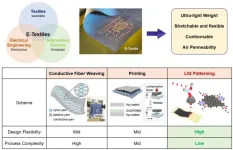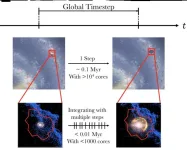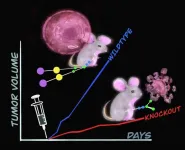(Press-News.org) MSU has a satellite uplink/LTN TV studio and Comrex line for radio interviews upon request.
THIS STORY IS UNDER EMBARGO UNTIL OCT. 26 AT 12:01 A.M. EDT/05:01 A.M. U.K. TIME.
Images
Highlights:
Researchers at Michigan State University have developed a framework that can help scientists understand trends in biodiversity by using data from well-characterized species to provide insights on data-deficient species.
The framework is published in the Journal of Animal Ecology, which provides a how-to guide for researchers and practitioners to implement.
Roughly one in seven species are classified as data deficient by the International Union for Conservation of Nature, or IUCN.
That means these species lack sufficient data for the IUCN to assert a conservation status and, consequently, their need for conservation interventions.
With the new framework, researchers and their partners in conservation and wildlife management could better identify which data-deficient species are threatened and in need of help.
EAST LANSING, Mich. – Elise Zipkin and her team at Michigan State University have developed a sort of “Robin Hood” approach to better understand and protect the world’s biodiversity.
They’re using information from well-quantified animals to reveal insights about less common, harder-to-observe species. That is, they’re taking insights from the data-rich and giving to the data-poor.
Now, they’re sharing their methods with the wider research and conservation community in the Journal of Animal Ecology. Additionally, the computer code behind that methodology is freely available on the group’s GitHub page.
“We’re losing biodiversity so rapidly that we’re no longer in a position to ask what’s going on with every species individually,” said Zipkin, who is an associate professor in the Department of Integrative Biology at MSU.
She is also the director of MSU’s Ecology, Evolution and Behavior program, or EEB.
“At the same time, we have unprecedented amounts of data and computing power,” Zipkin said. “We have to think more strategically about how to take advantage of those data to answer the tough questions.”
A community approach
Currently, about one in seven species are classified as data deficient by the International Union for Conservation of Nature. That means these species lack the data needed to inform their conservation status, which, in turn, helps determine conservation strategies.
“There are so many species where we don’t have the data to tell us exactly what’s going on,” Zipkin said. “We need more rapid and efficient assessments of those species if we want to figure out how to protect and conserve them.”
To that end, Zipkin and her Quantitative Ecology Lab have introduced a framework based on what are known as “integrated community models.” In their paper, the researchers show how they design and implement these models to utilize data from the best-characterized species in a community to assess other members of the group.
“We’re borrowing strength from the species that have the most information or are most common,” Zipkin said. “This allows us to get species-level estimates for all members of a community, and also a comprehensive understanding of what’s going on with the community as a whole.”
The new publication is the culmination of a multi-year project supported by the National Science Foundation. In addition to Zipkin, the team included postdoctoral research associate Jeff Doser; graduate students Wendy Leuenberger, Samuel Ayebare and Kayla Davis; and Courtney Davis, who worked on this project as a postdoctoral fellow in Zipkin’s group before becoming a research associate at the Cornell Lab of Ornithology.
Zipkin described the new report as a how-to guide for anyone who wants to use the team’s methods to draw insights from a variety of different data sources describing multiple species.
In that guide, the team provided three case studies: forest birds in the northeastern United States, butterflies in the Midwest and a simulation scenario for 10 hypothetical species.
The results show how integrated community models can be used to estimate species’ trends and demographic rates over space and time, even for rarer species.
In publishing this report and the associated computer code, Zipkin said the team’s immediate goal is to get these methods into the hands of more researchers. The next step will be working with partners in government and nongovernmental organizations who can use information from the models as they develop conservation strategies.
“We believe this will be a really useful way to enable more effective and efficient conservation planning,” Zipkin said. “We can move from a species-by-species approach to working more holistically.”
By Matt Davenport
###
Michigan State University has been advancing the common good with uncommon will for more than 165 years. One of the world's leading research universities, MSU pushes the boundaries of discovery to make a better, safer, healthier world for all while providing life-changing opportunities to a diverse and inclusive academic community through more than 400 programs of study in 17 degree-granting colleges.
For MSU news on the Web, go to MSUToday. Follow MSU News on Twitter at twitter.com/MSUnews.
END
MSU’s ‘Robin Hood’ approach for tracking biodiversity
2023-10-26
ELSE PRESS RELEASES FROM THIS DATE:
Bone density is kept up by the same process with hair color
2023-10-26
Osaka, Japan – Bone is maintained via delicate balance between formation and resorption, and its imbalance leads to bone related diseases like osteoporosis rheumatism and periodontitis. In studies published in scientific journals J Biol Chem and Cell Struct Funct, researchers led by Osaka University revealed proteins named Rab32 and Rab38 play pivotal roles in bone resorption in osteoclast, cell specialized in the process. These proteins are also crucial for pigmentation of hair and skins.
Bone ...
Multimodal graphene-based e-textiles for the realization of customized e-textiles have been developed for the first time in the world
2023-10-26
Multimodal* graphene-based electronic textiles (e-textiles) for the realization of customized e-textiles have been developed for the first time in the world.
* Multimodal means the process by which information is exchanged through various sensory interfaces such as visual sensation and auditory sensation.
The joint research team led by Principal Researcher Soongeun Kwon of the Department of Nano Manufacturing Technology of the Korea Institute of Machinery and Materials (President Sang-jin Park, hereinafter referred to as KIMM), an institute under the jurisdiction of the Ministry of Science and ICT, and Professor Young-Jin Kim of the Department of Mechanical Engineering ...
Treating amphetamine use disorder with stimulants: an encouraging new approach
2023-10-26
A new study has found that it may be possible to use stimulants to treat stimulant use disorder. People with amphetamine-type stimulant use disorder who are treated with prescription psychostimulants such as methylphenidate and dextroamphetamine (commonly used to treat attention deficit hyperactivity disorder (ADHD)) may lower both their craving and stimulant use, especially if such treatments are administered at high doses. This study was led by Dr. Jutras-Aswad, a researcher at the CHUM Research Centre and a professor of psychiatry and addictology at Université de ...
Does guideline-based treatment prevent racial disparities in cardiovascular outcomes?
2023-10-26
Philadelphia, October 26, 2023 – Cardiovascular disease remains the leading cause of death for women within most racial and ethnic groups in the United States. A new study in the Canadian Journal of Cardiology, published by Elsevier, characterizes the risk profile for black and nonblack women with obstructive coronary artery disease (CAD) enrolled in the Women’s Ischemia Syndrome Evaluation (WISE) cohort study. It concludes that racial and ethnic disparities in long-term cardiovascular outcomes were not observed among women ...
Genetic risks of autism and ADHD may be related to more screen time in children
2023-10-26
A team led by Nagoya University Graduate School of Medicine in Japan has investigated screen time in autistic (ASD) and ADHD children. Screen time refers to the amount of time a person spends on a device with a screen, such as a smartphone, computer, television, or video game system. The researchers found that children with a genetic predisposition to ASD were more likely to use screens for longer periods. Meanwhile, children with ADHD gradually increased their screen time as they grew older, even if their initial screen use time was short. They published their results in the journal Psychiatry Research.
People ...
Deep learning speeds up galactic calculations
2023-10-26
Supernovae, exploding stars, play a critical role in the formation and evolution of galaxies. However, key aspects of them are notoriously difficult to simulate accurately in reasonably short amounts of time. For the first time, a team of researchers, including those from The University of Tokyo, apply deep learning to the problem of supernova simulation. Their approach can speed up the simulation of supernovae, and therefore of galaxy formation and evolution as well. These simulations include the evolution of the chemistry which led to life.
When you hear about deep learning, you might think of the latest app that sprung up ...
Cancer's sweet Achilles heel
2023-10-26
Kyoto, Japan -- An old campaign slogan for cough syrup, "It tastes awful. And it works," seemed to imply that any sweet content might have diminished the medicinal effect.
Sweetness, in the case of cancer, appears as a chain of sugar molecules attached to proteins by beta1,4-galactosyltransferase-3, or B4GALT3 According to the Cancer Genome Atlas, a high expression of this enzyme is associated with noticeably shortened survival rates in several types of immunotherapy cancers, such as neuroblastoma, ...
Brain implant at OHSU successfully controls both seizures and OCD
2023-10-26
A patient at Oregon Health & Science University is the first in the world to benefit from a single stimulator implanted in the brain to effectively control two life-altering conditions: seizures caused by epilepsy and compulsive behavior caused by obsessive-compulsive disorder, or OCD.
Amber Pearson, 34, of Albany, said her seizures are under better control, but the relief from her psychiatric condition is profound.
“OCD is worse than having the seizures,” she said. “Epilepsy brings limitations to my life, but OCD controlled it.”
In the case study, published in the journal Neuron, co-authors from institutions across the ...
Brain injury expert says important changes still needed to law defining death despite reform pause
2023-10-26
After surveying the views expressed by 41 advocacy, medical, and transplant-focused organizations on the Uniform Determination of Death Act, a brain injury expert is calling for much-needed reforms to the legal definition of death in the United States. The recently announced pause by the Uniform Law Commission, which is spearheading revisions, is disappointing, the expert notes, but should not permanently stall practical fixes to longstanding problems with the Death Act.
“This study shows that most medical ...
Study examines racial differences in care among older Americans
2023-10-26
Older Black Americans are more likely to receive low value acute diagnostic tests than older White Americans, while older White Americans were more likely to receive low value screening tests and treatments, finds a study published by The BMJ today.
Low value care refers to services that provide little to no benefit yet have potential for harm, which can include laboratory tests, scans, and medication.
These differences were generally modest and were largely driven by differential treatment within health systems. But the researchers say the results “highlight ...



